It is well known that Italy has a lot to offer in terms of cocktails. From the Vermouth belt downwards, the typical north-south divide can be observed, which seems to come to an end with a final surge in Florence, before Rome, the eternal city, puts the crown on the whole thing. Towards the south, things seem to be thinning out.

But at the latest since Naples’ speakeasy jewel l’Antiquario made it into the World’s 50 Best Bars of 2022, this should no longer be a blank spot on the map. If you search for “cocktail bar” on Google maps, the map of the city on Mount Vesuvius resembles a pincushion. But where you can buy a Spritz to go for 1.50 euros and every street café is better stocked with spirits than many a “bar” here, you have to take a closer look to find what you are looking for.
But you will be rewarded with success! During our stay in Naples, we visited five bars that deserve an introduction. At this point, we should also remember the countless, dearly departed Campari Spritz on the way.
Ex Falegnameria
- Vico Lungo del Gelso, 73, Napoli, Quartieri Spagnoli, @ex.falegnameria
After moving into our hotel on the slopes of Vomero hill, we were drawn to the narrow streets of the Quartieri Spagnoli below. They have borne their name since the 16th century, when Naples was ruled by the Spanish viceroy Pedro Álvarez de Toledo.


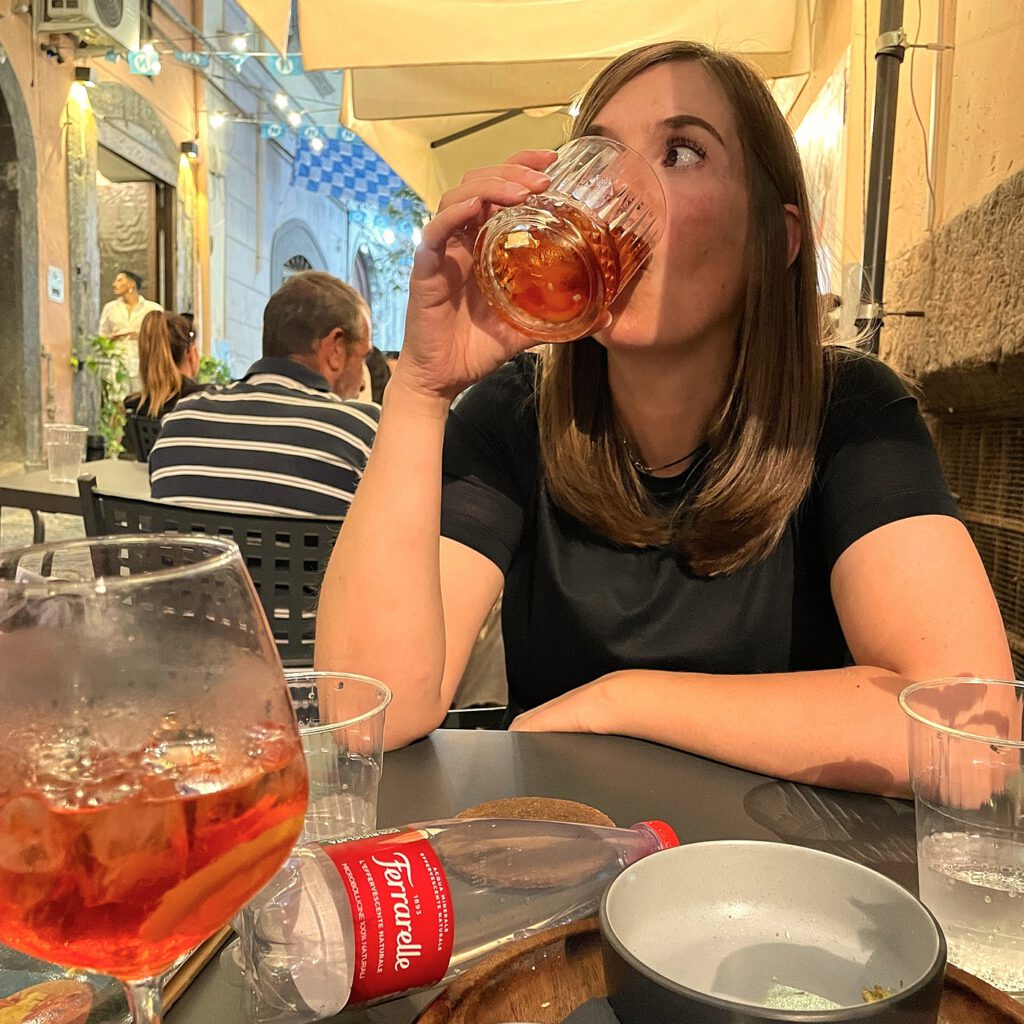
Our first real Neapolitan pizza at Pizza e Passione then had to be baptised at Ex Falegnameria. The cosy little shop, which according to its name used to be a carpenter’s workshop, is complemented by outdoor tables in the alley. Stephanie stuck with Negroni Sbagliato, while I had a classic Negroni first, to which the Punt e Mes added a nice spicy distress instead of a regular vermouth. For me, the second round was then the ceremonial opening of the Tour de Campari Spritz of the days to follow. The cocktail menu at Ex Falegnameria is small, but chosen with taste and savvy. To the classics on offer, there is always the option of a deluxe version with more expensive spirits. You can’t expect any mixological surprises, but like everywhere else in Naples, you can expect tasty nibbles to go with your drink. In the midst of the morbid charm between the simple realities of life and the tourist places, Ex Falegnameria is an oasis of good taste and solidity in the Quartieri Spagnoli.
Barrio Botanico
- Via Medina, 24, Napoli, San Ferdinando, @barrio_botanico
For the time until our table reservation at the Osteria da Antonio in the San Ferdinando district, not far from the ferry port, we could think of nothing better than a delicious drink in the Barrio Botanico. Through a monumental gateway, we entered the spacious courtyard of the late Baroque Palazzo Fondi, which serves as the bar’s outdoor terrace. The opulent building was built in the 18th century by Gian Giacomo de Marinis, the Marquis of Genzano. His great-niece Maria Costanza de Marinis and her husband Giuseppe Sansevero di Sangro rebuilt the palazzo to its present form between 1799 and 1824. The Neapolitan di Sangro family had acquired the principality of Fondi in Latium in 1751, hence the name Palazzo Fondi. (However, the price of 200,000 ducats is said never to have been paid).


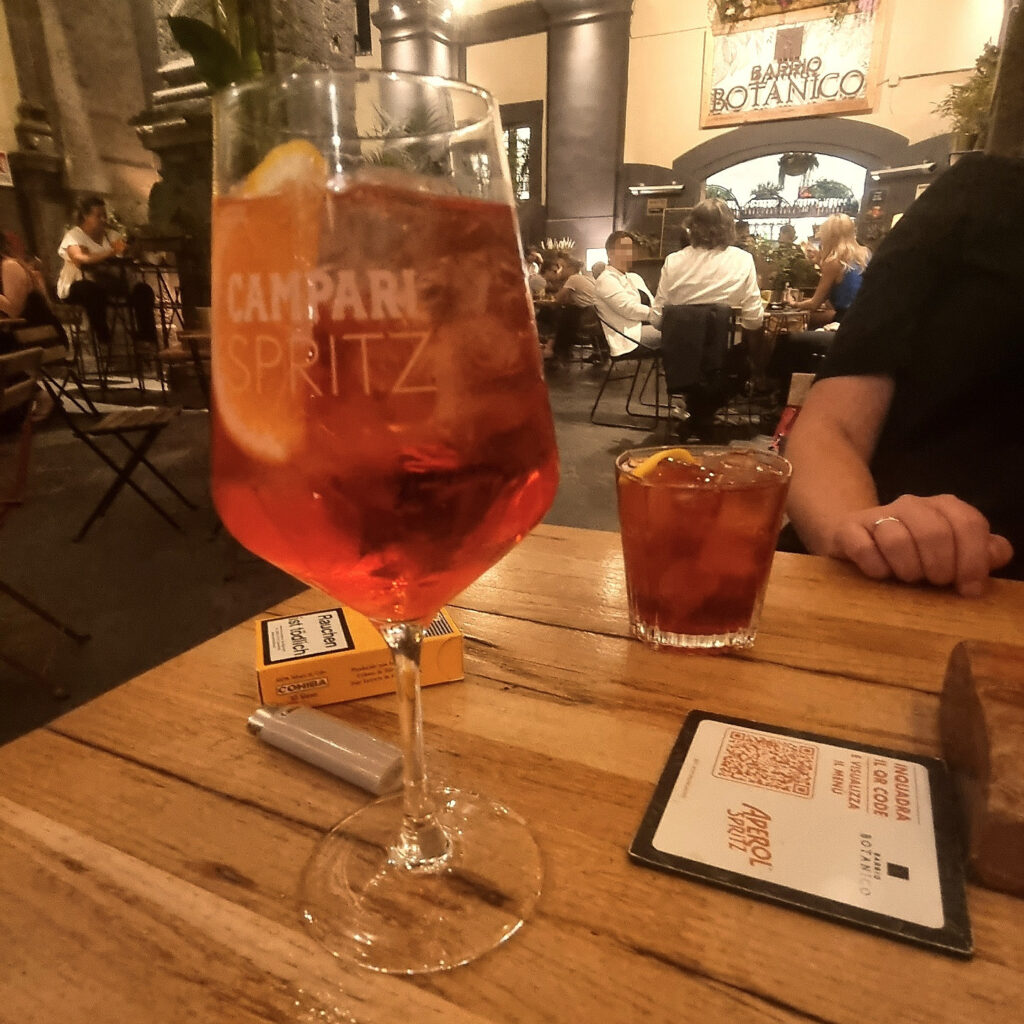
The inner courtyard is covered with a transparent tarpaulin that converges in a funnel shape in the middle and arrives at the ground as a column. The effect when it rains must be great, but we are also not sad that we didn’t see a drop of it during our holiday. In the courtyard and portico opposite the entrance, where the bar is also located, you sit very nicely and can get advice on the extensive bar menu, which offers signature drinks and classics.


Stephanie had a “Neapolitan Lemon Tree”, which despite a colourful palette of ingredients (gin, Italicus, Limoncello, lemon juice, ginger syrup, Bitter Bianco and mint infusion) could also have been a proper Tom Collins, to be honest. My fantastic “Cigar Proof” with Monkey Shoulder Scotch, Hierbas, cherry liqueur, Cynar 70 Proof (hard to get in Germany) and cherry bitters did full justice to my desire for strong flavours and a noticeable alcohol content. We were convinced enough to return again after our delicious fish dinner at Antonio’s – although this time we asked that our full bellies be spared the free snacks. The first after-dinner round was mainly filled with – against all conventions – aperitivi. Only the “Hanami” with mezcal, vermouth, Provence tea syrup and lime juice and syrup was my thoroughly convincing choice from the signature list. We agreed that we would also like to go to Barrio Botanico again. However, it speaks for Naples that it didn’t come to that.
La Fesseria
- Via Giovanni Paladino, 17, Napoli, Centro Storico, @la_fesseria
We actually wanted to go to a small pizzeria that had thrilled me six years ago. Apparently, however, the place had become Insta-hype and the queue of followers met us one street crossing before. Fortunately, in Naples’ Centro Storico, you don’t have to look far for another good pizza that hasn’t been infested by a locust swarm of Insta-victims. Thanks to Trattoria Pizzeria Bella Napoli for the great pizza! It’s a pity that I only realised afterwards that behind the fence at my back were the excavations of a larger building complex from the Roman imperial period (Carminiello ai Mannesi).
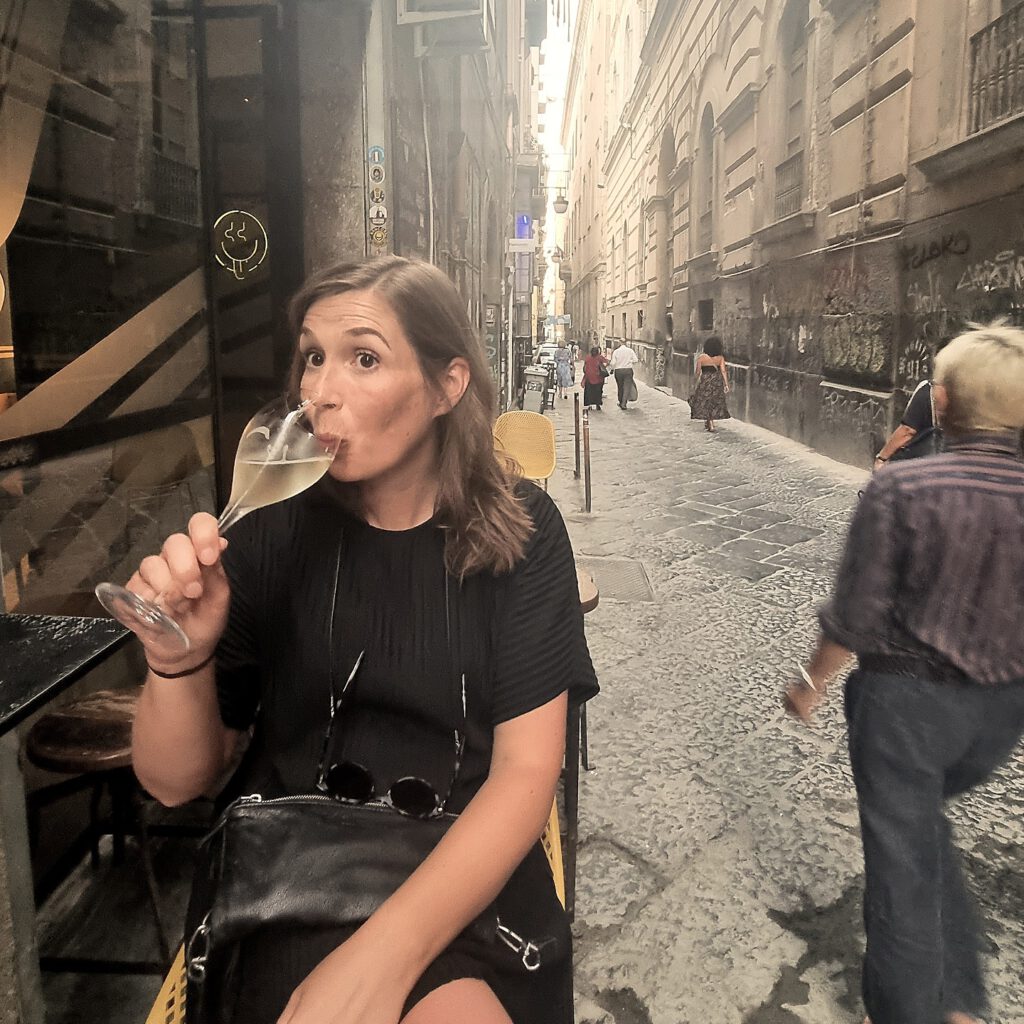
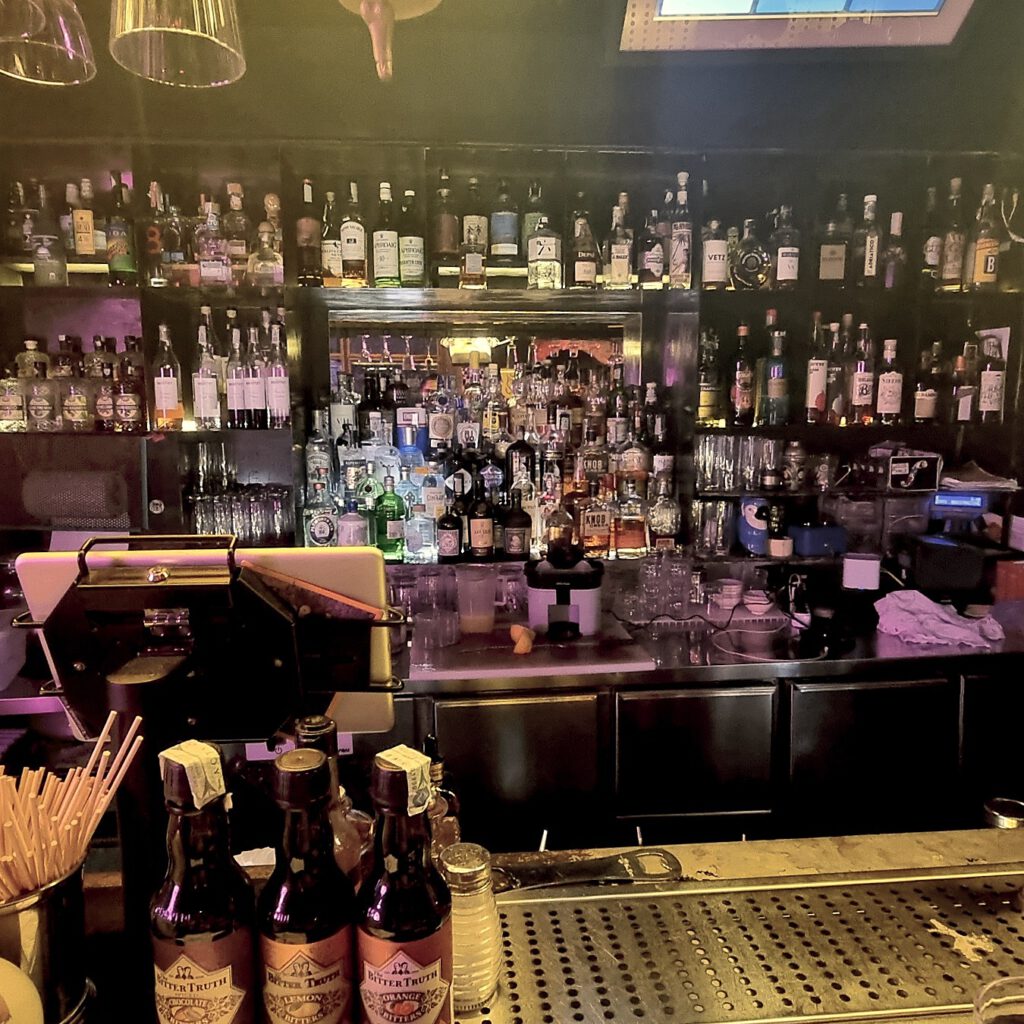

Of course, that makes you thirsty, which we wanted to quench appropriately. La Fesseria now consists of three pubs, two of which are very close to each other in a narrow side alley of the Centro Storico. Early birds that we are, Ciro, the bartender, asked us to be patient for a moment and have an aperitif in the Fesseria Enoteca (wine bar) next door. An excellent prosecco from Casa Canevel was then just the thing to sweeten the wait.


When we finally took up position in front of the cocktail Fesseria, I knew that nothing could go wrong if the bartender was named like the historic Ciro’s in London. I had a “Clementina in Vetrina”, a very tasty sour made with mezcal, mandarin liqueur, lime juice and San Gennaro syrup (whatever that is exactly). Stephanie had a “Bitter Mood”, a great highball of Campari, Chinotto bitter orange liqueur, lemon juice and honey, the whole topped with Lurisia tonic, which also contains bitter orange. (To anticipate: We went back to the Fesseria the next day for a “Bitter Mood” for each of us). My second drink was a “Repubblica delle Banane”, an old fashioned made with banana whisky (infused, I suppose), chocolate bitters and sugar syrup. The drink was not for my wife at all, but all the more for me. A worthy sparring partner beyond the Alps for the “Banana Joe” at Seiberts. We felt incredibly comfortable with Ciro at the Fesseria, with its modern, relaxed atmosphere, offering great drinks on the cutting edge. Absolutely no foolishness (“fesseria”) to stop in here. Our favourite in Naples!
Scotto Jonno
- Galleria Principe di Napoli XIV-XVII, Napoli, Montecalvario, @scottojonno
Once out of the National Archaeological Museum, you drop across the street and stand in front of the monumental neo-baroque façade of the Galleria Principe di Napoli. The building seemingly never quite fulfilled its purpose as a lively shopping arcade, as instead of noble shops, it was mainly administrative institutions and offices that rented space in the magnificent halls. In 1965, the north façade of the neglected building had completely collapsed, and even today the littered portico does not present a particularly inviting image to the outside world. All the more pleasant is the surprise when you enter the glass-roofed passage from the end of the 19th century. It looks like a scaled-down version of the famous Galleria Vittorio Emanuele II in Milan (or the Galleria Umberto I in Naples itself), but it is only open on three sides (because one side is blocked by the church of Santa Maria di Costantinopoli).
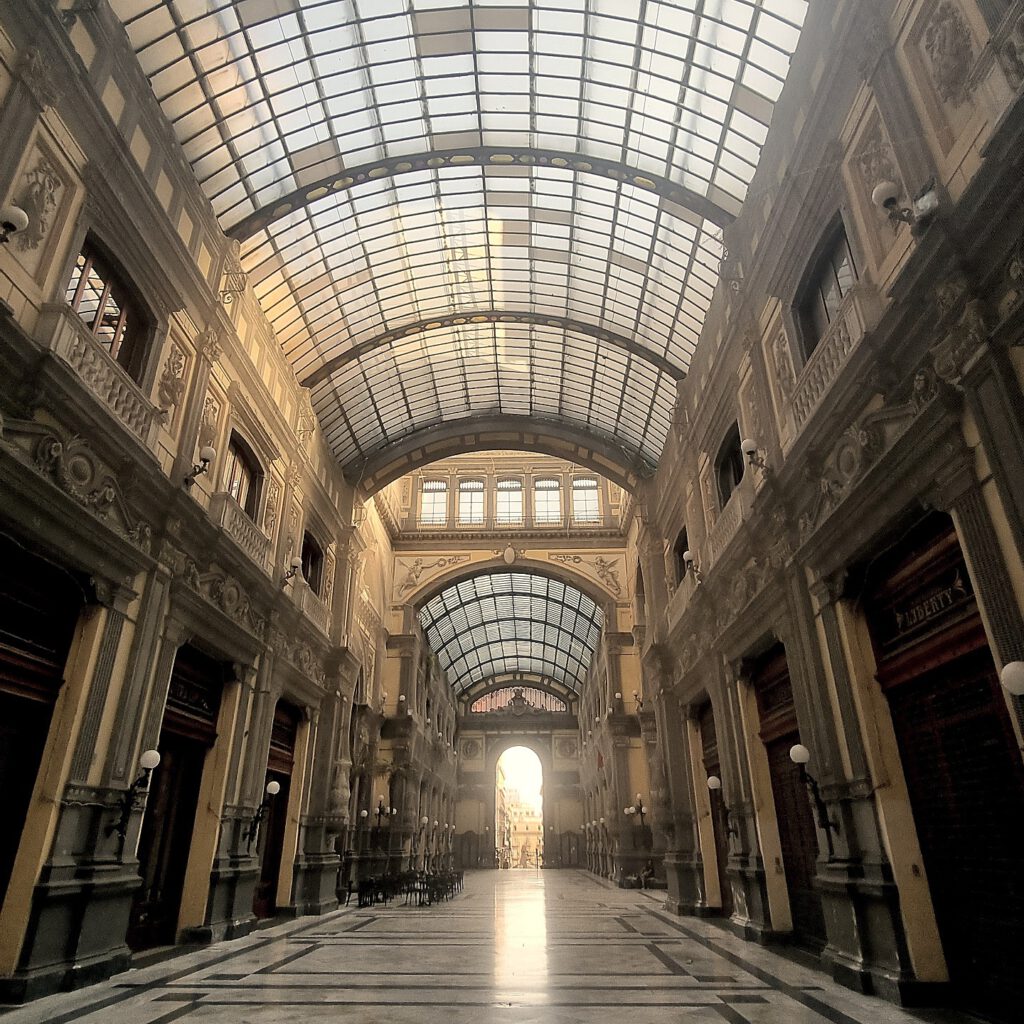
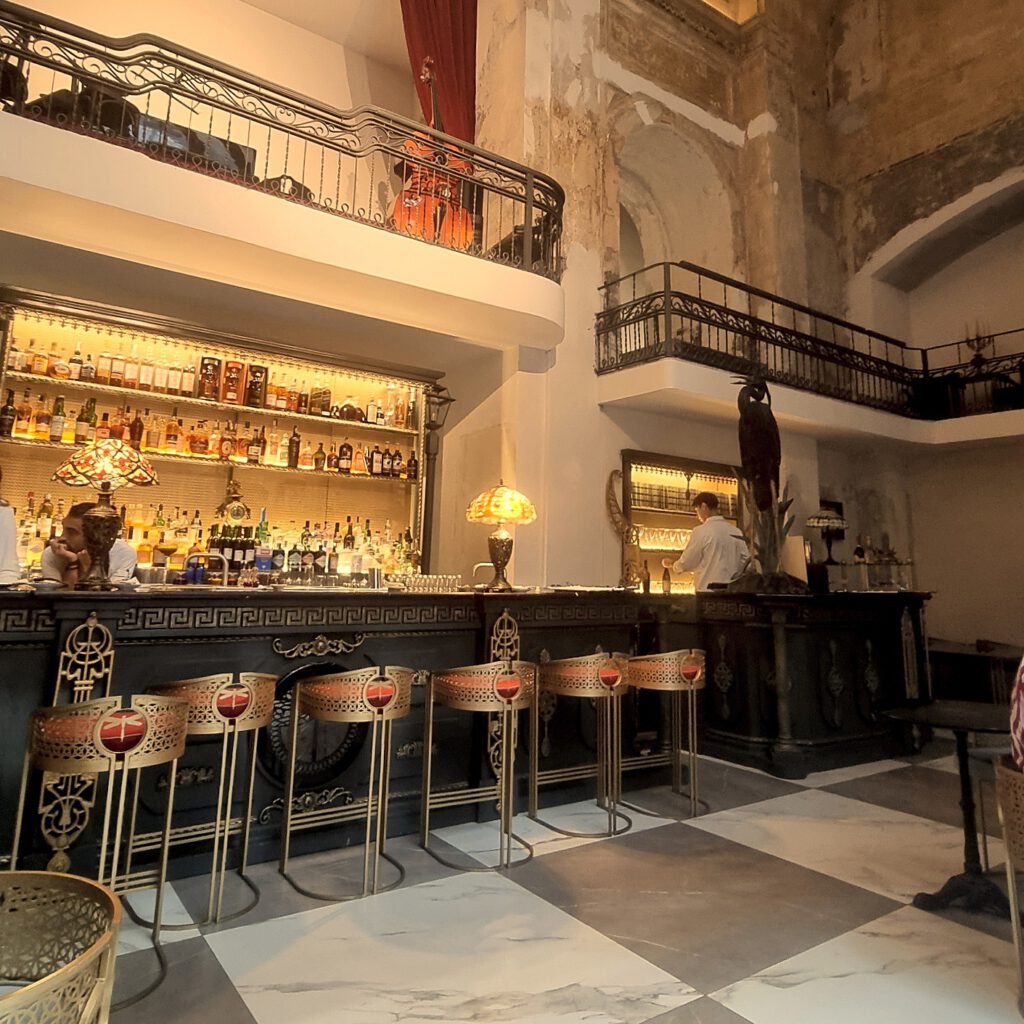

In the place where the east wing would otherwise open up is the Scotto Jonno, which manages to combine the style of the Belle Époque with the charm of hipster venues in Prenzlauer Berg (let’S have some bare plaster somewhere). In 1894, a certain Vicenzo Scotto Jonno had already opened a Café Chantant in the same place with the same name. A grand piano and a cello, which waited in the gallery above the bar, indicate that there is also live music here from time to time, accompanied by cocktails and delicious food. The awareness of history continued on the menu, as there were dates given to each of the few cocktails.
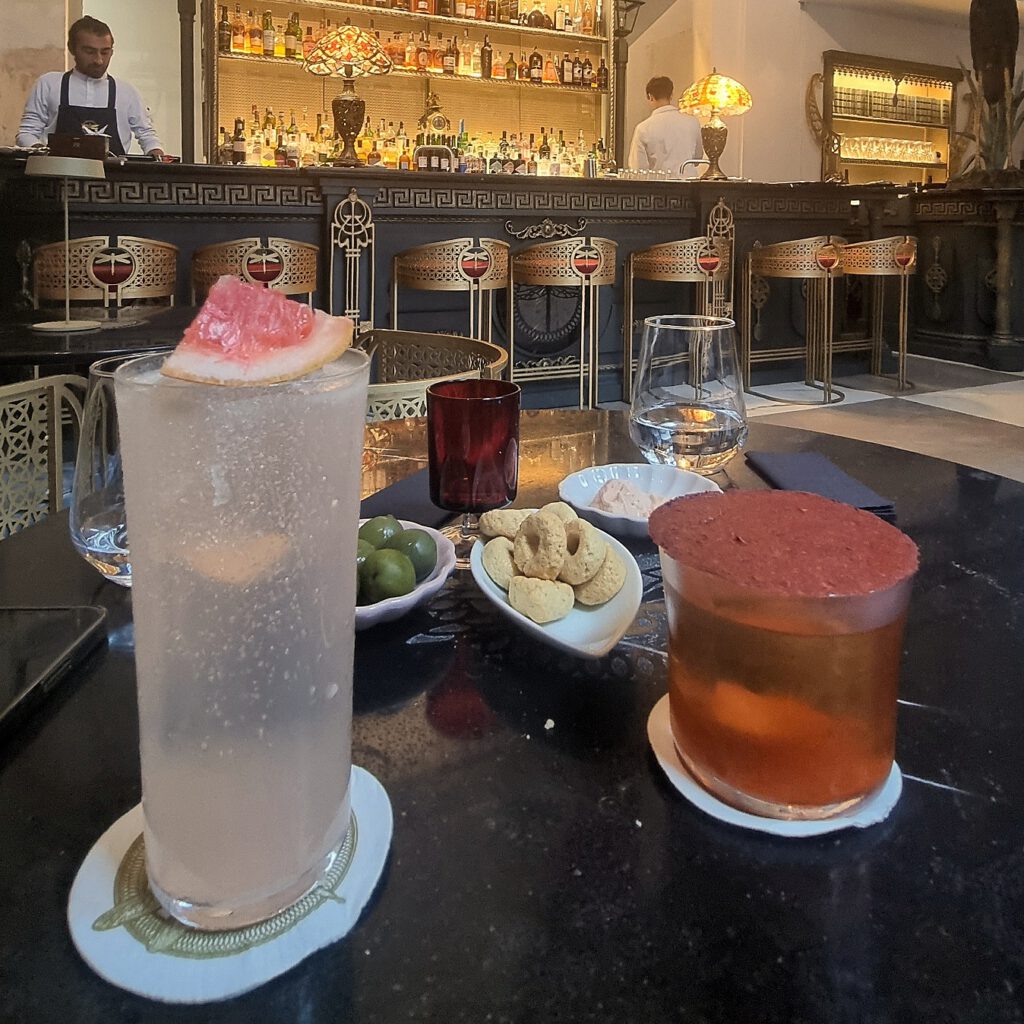

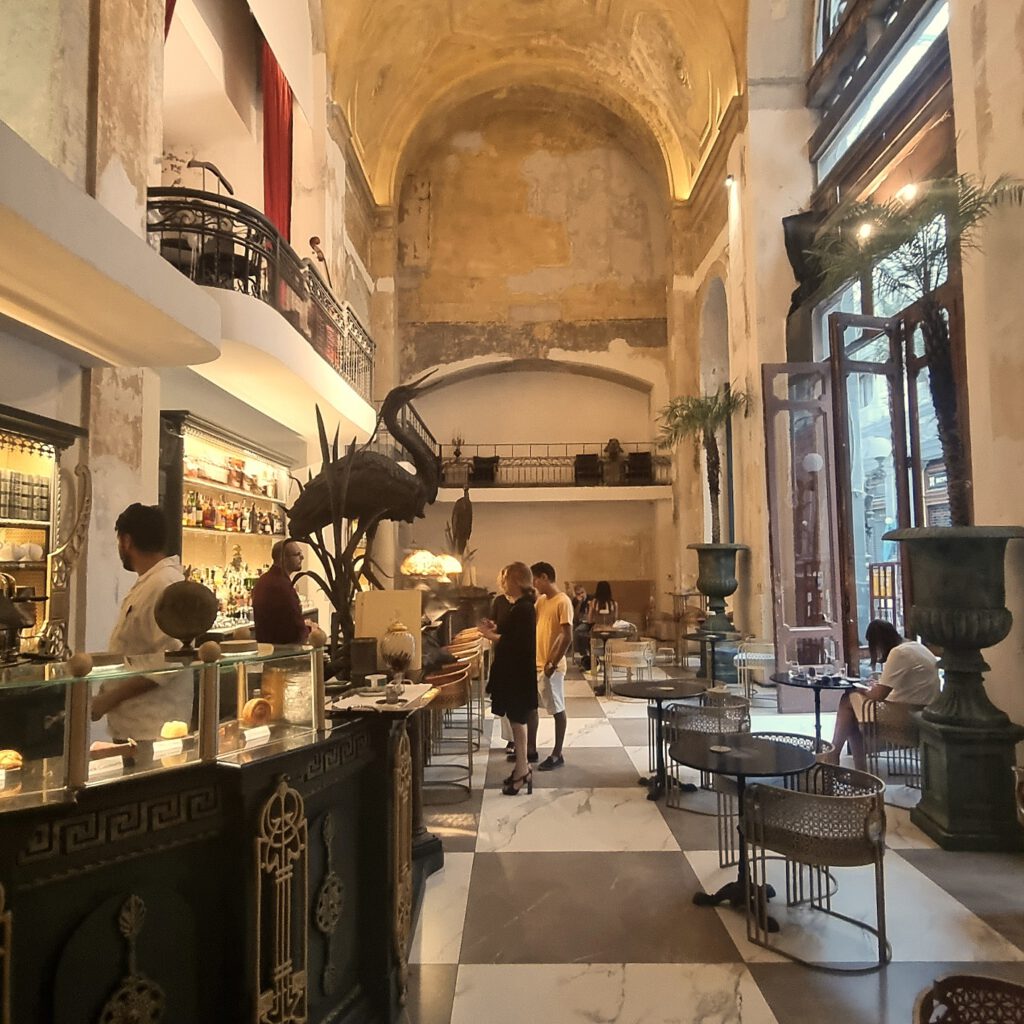
With the “Cardinale”, which is more or less a Negroni with dry instead of red vermouth, I had the latest drink from the menu. It is not to be confused with the German “Kardinal” which, like its model, the “Bischof”, was a punch with bitter orange. However, the Cardinale was probably originally made with Riesling instead of dry vermouth. The drink was invented in 1950 by Giovanni Raimondo, the bartender at the Hotel Excelsior in Rome, inspired by a German cardinal who was a regular guest when the tenth anniversary of Pope Pius XII was celebrated (thus 1949). Luca di Francia, who currently holds Raimondo’s position, found this out. Stephanie’s Negroni Sbagliato wasn’t on the menu and when I asked if they also had signature cocktails besides the classics, I found out that we were still looking at the breakfast menu. Nice!
The regular cocktail menu was much more extensive. Stephanie had a wonderful Paloma and I couldn’t resist “La Strega del Vesuvio”, the “Witch of Vesuvius”: scotch, gin, cordial of regional piennolo tomatoes and celery, and student flower soda. Under a wafer-thin, super-aromatic lid of dried tomato paste, additional smoke surprised, making the drinkable volcano experience in the shadow of Mount Vesuvius perfect.
Scotto Jonno only opened in March and I suspect this won’t be the last you hear from them. Travellers to Naples who are in the vicinity should definitely make a stop here.
L’Antiquario
- Via Vannella Gaetani, 2, 80121 Napoli NA, Italien, @lantiquario_napoli
We wanted to end our trip in a particularly nice way and had therefore booked a table at L’Antiquario right at the beginning. Unfortunately, however, we were no longer up to our strength: the best way to get to know cities is on foot, so we had 90 km on the pedometer at that point. All the great food that Naples had to offer everywhere and in all its varieties, the little sleep and the occasional Campari Spritz were starting to take their toll. That’s why I’m sorry we couldn’t give the flagship of the Neapolitan cocktail landscape more of the energy and attention it deserved.
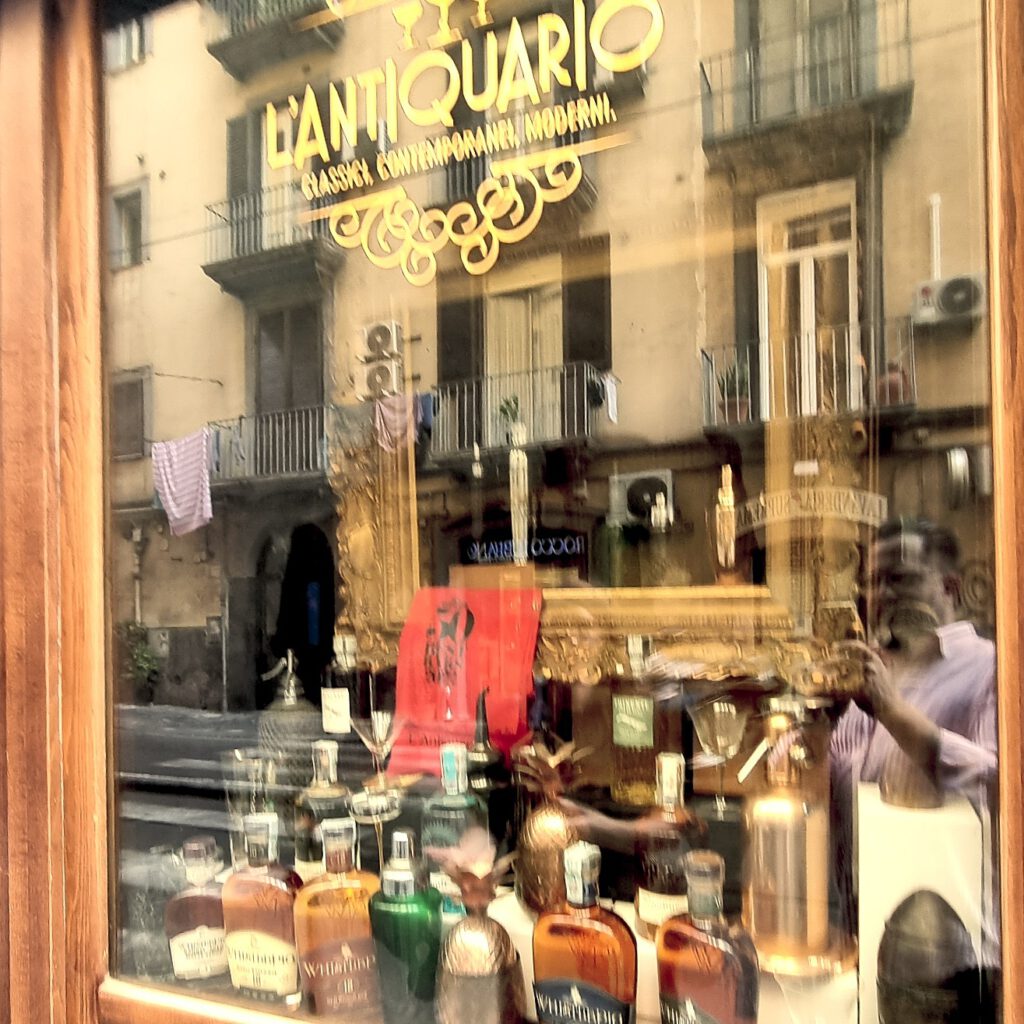


In a grey, busy street that connects Naples’ centre with the chic Chiaia district, an inconspicuous door and a small shop window hide old junk that actually makes you think of an antique shop (“antiquario”). If the characteristic silhouettes of old cocktail utensils and bottles hadn’t caught my eye, we would have walked past unsuspectingly during the day. In the evening, you are greeted in a friendly manner at the door and one of the obliging and informative waiters leads you to your table in the dark speakeasy. Pictures hang everywhere and there are plenty old objects, without it looking restless or uncomfortable. On the wall where our table was, for example, surrounded by bottles, books and ice cube moulds, hung an ancient print of William Hogarth’s “Punch Party” from 1733. The old temperance champion would certainly not have liked that.


The drinks menu is heavily influenced by Italian bar classics. So Stephanie had the “Americano Fiore” from the Americano special menu with St. Germain and Jasmine & Peach soda, among others. I couldn’t resist a set of three different Negroni, which varied greatly in colour and taste. There were intense and surprising flavours at work here, which I’m afraid I can’t recall from memory. Roughly speaking, one was peach-based, one had an umami theme and the last was infused with coffee. The bitter notes and herbs were sometimes challenging for my German palate, but it was exciting to see the range that a drink can have, which for me actually only ever consists of three equal parts of gin, Campari and vermouth. My farewell drink was then a delicious and quite pleasing “Americano Zagara” with red vermouth infused with orange zest, Martini bitters, orange blossom water and pink grapefruit soda.
Naples is definitely worth another visit – but then we’ll start the trip with the great l’Antiquario, when we’re still in full possession of our strength. Ciao, bella Napoli, alla prossima!